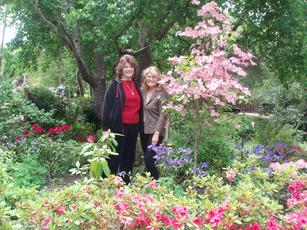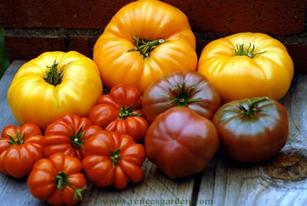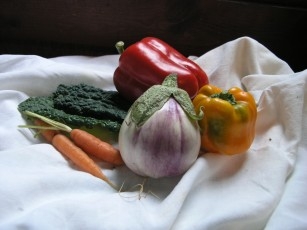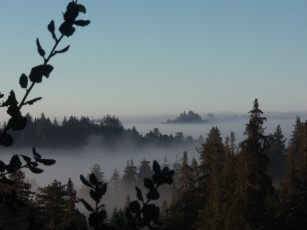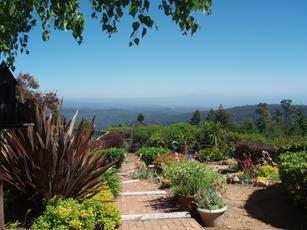 Enter the Hidden Gardens of Bonny Doon with me as I preview several gardens that will be featured on the tour this coming weekend. While some of our gardens have a few areas with a "wow factor" , the gardens I was privileged to visit have this element at every turn. I was amazed, impressed and truly honored to spend time in each of them.
Enter the Hidden Gardens of Bonny Doon with me as I preview several gardens that will be featured on the tour this coming weekend. While some of our gardens have a few areas with a "wow factor" , the gardens I was privileged to visit have this element at every turn. I was amazed, impressed and truly honored to spend time in each of them.
First stop was a garden that took my breath away. Looking past the lush lawn, the view takes in all of Monterey Bay. It wasn't always this way, the owner explained. When she moved to the property in 1981, she didn't even know there was an ocean view. It was only after some judicious pruning that this stunning view was revealed.
We ambled through the many paths that took us up close and personal with perennial beds overflowing with blooming iris, spirea, weigela, succulents, hardy geraniums, coprosma and coleonema to name just a few.
Rabbits are an ongoing problem in this garden. Seems they love her Angelina sedum, coprosma, and Rose Campion as much as she does. Little 12" tall fences surround several of the beds which looks comical but apparently works as the rabbits don't like to jump over them.
Stained urbanite has been stacked by the owner to make short retaining walls and the look is quite classy blending in the flagstone and gravel paths. She explained how easy it was to stain the broken concrete from the old driveway by slapping on some concrete stain. "Piece of cake", she told me.
Other flower beds she edged with Sonoma fieldstone, stacking them herself. At every turn you can see the personal touches that make a garden unique. An old rusty mailbox was tucked into one of the beds overflowing with blooming pansies and million bells calibrachoa. I loved this garden.
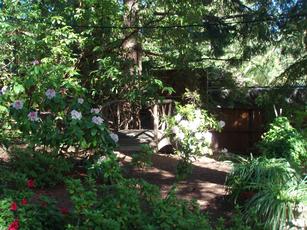 Next stop was another garden 30 years in the making. You won't believe the "before" pictures when you see this garden now. I could barely see the potential in the old pictures but the owner could and started to build up the rock hard soil bed by bed. After many years she has created an organic garden full of flowering rhododendron, roses, viburnum, herbs, vegetables, citrus, apples and a 5 year old Staghorn fern that measures 4 ft across.
Next stop was another garden 30 years in the making. You won't believe the "before" pictures when you see this garden now. I could barely see the potential in the old pictures but the owner could and started to build up the rock hard soil bed by bed. After many years she has created an organic garden full of flowering rhododendron, roses, viburnum, herbs, vegetables, citrus, apples and a 5 year old Staghorn fern that measures 4 ft across.
The owner explained that deer are not a problem because they won't jump the irregular picket fence. Seems the wide pickets confuse their eyesight. Unfortunately, the gophers have decided recently that after 14 years, her camellias are now on the menu and she has lost almost all of the original 40 in the past year. Instead of lamenting her loss, she sees it as an opportunity to add new plants. She has the optimism that all gardeners possess.
Chickadees nested in a box attached to the porch. Garter snakes and alligator lizards patrol the flower beds. A bathtub, sunk into the earth serves as "the poor man's hot tub". Old metal chairs are planted with flowers and ferns and other found garden art is sprinkled generously though out the garden. This is the garden of an artist whose studio is nestled back among the trees. At every turn you feel the peacefulness of this wonderful place. This is a garden to experience not just view.
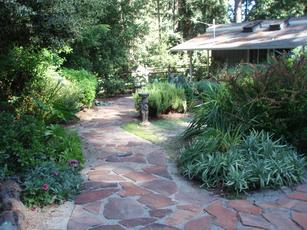 The last garden I was lucky enough to preview, was an asphalt driveway just 6 short years ago. There are occasional unplanted spots that still show asphalt. What a transformation. With the help of lots of top soil and an auger this gardener has created a spectacular space. "Everything grows like crazy here", she explained.
The last garden I was lucky enough to preview, was an asphalt driveway just 6 short years ago. There are occasional unplanted spots that still show asphalt. What a transformation. With the help of lots of top soil and an auger this gardener has created a spectacular space. "Everything grows like crazy here", she explained.
The front garden is open to deer and is planted with echium, leucospermum, arctotis, barberry, thyme, rosemary and New Zealand flax. One of her favorite plants is a huge variegated holly that buzzed so loudly with bees I thought the electrical line coming into the house was making all the racket.
In the back, a small orchard edged the fence. Blooming lilacs by the deck heavily scented the air. Succulents intermingle with peony, erysimum and gaura. This gardener explained she " she is one of those people who buys whatever she likes and then finds a place for it". Having had previous experience growing grapes and olives in Sonoma, she is a hands-on gardener who does it all herself. She's a self-described "drip queen".
A ceramic artist, her sculptures are focal points though out the garden. There is a lot of other garden art in this garden, too.
Where do these gardeners find the garden art, water features and other items that give their gardens that personal touch? One explained, she is always on the lookout for estate sales as she drives around or sees advertised in the paper. "That's were you can really find the treasures", she explained. "Little old ladies have some great plants and other wonderful finds in the back of the garden".
The Hidden Gardens of Bonny Doon Tour takes place Saturday and Sunday, May 19th and 20th. Don't miss it.

